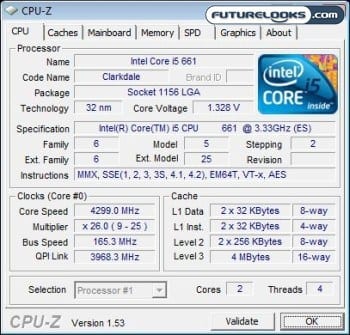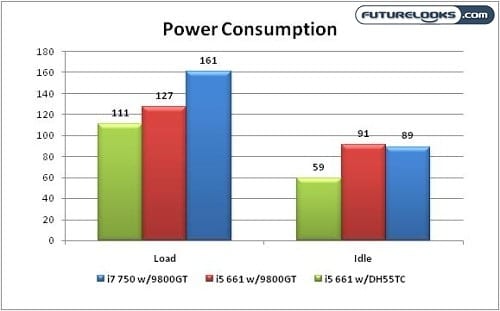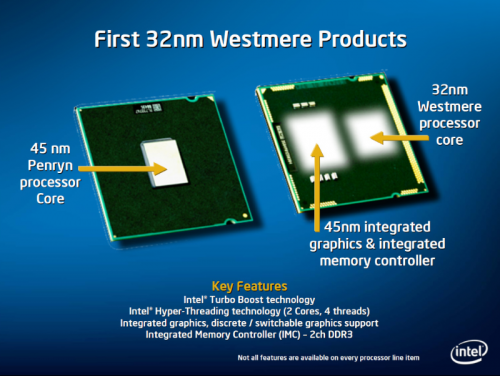Overclocking Made Easy
Because it’s a Dual Core, it gives you plenty of head room as long as you don’t try it on the DH55TC motherboard. There’s far less circuitry to overclock compared to physical Quad Core processors. Overclocking the CPU doesn’t affect the integrated GPU, otherwise it wouldn’t possible.

Using the ASUS P7P55D Pro motherboard and Auto settings in the BIOS, the system achieved a very quick 4.3GHz. With a bit more fiddling with the voltages and timings, the system maxed out at about 4.4GHz. Your overclocking achievements will vary of course. At least you know this isn’t a crippled processor and that some crazy overclocks with little effort can be achieved. Getting an extra GHz out of a CPU is nothing to stick your nose up at and with some more sinister cooling methods, you can see that 5GHz probably isn’t off limits.
Ultimate Power Consumption

Putting on our “Green” hat, we check out just how much juice the newly minted CPU sucks up. Yes, the Clarkdale would probably be catatonic if it used any less power. Keep in mind though that these results were taken with and without using a Zotac 9800GT 512MB video card. This is ideally where users are going to go when considering a micro-ATX platform, especially for Home Theater use. But again, even without an external graphics card, the system does do a lot of great things on its own.
Final Thoughts – How Does Clarkdale 32nm Measure Up?

The objective of the Dual Core i5 and i3 aren’t to compete with the stronger Quad Core processors per se. Their purpose is to take what we as consumers appreciate about Dual Core processors and almost double the performance of previous generation parts without doubling the price. Hence, we get a dual core CPU with Hyper-Threads which continues to be a first terms of CPU innovation. You could say, in an arrogant “Apple” sort of way that they “reinvented the dual core CPU”.
With features like Hyper-Threading, Intel is able to cut down on desktop and mobile power consumption immensely since it no longer powers four physical cores. That means that although it is physically a dual core system, it acts more like a quad core system, while requiring far less power. As you can see, this will help mobile users as well because their batteries will last so much longer. Again without an increase in relative price. That’s assuming laptop vendors don’t do something devious as to try and sell it to us as “their” feature. Hey, we’re looking out for the little guy!
That said, it’s another Intel first Stepping in the right direction. While the 32nm dual core Hyper-Threaded CPU line deserve an Editor’s Choice because it is innovative, it’s weaker memory controller gives us reason to pull back on the reigns. Granted, it does have twice the memory bandwidth of the Core 2 series, but it would be a real value if it had a better controller similar to its Core i5 750 sibling.
Pros
- Impressive innovation
- Surprisingly low power consumption
- Perfect for Home Theater and entry level PCs
- 32nm overclocks to 4GHz and above
- CPU offers more than enough power for gaming
Cons
- Weaker memory controller
Overall Rating: 9.0/10.0


Love This Review? Hate This Review? Tell Us In The Forums!
